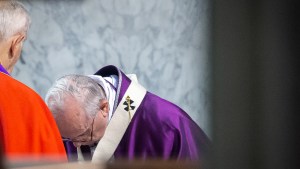It’s a historical reality that not many people realize today, but long periods of intense fasting, interspersed with jubilant days of high feasting, were the norm for many centuries of Christian religious practice.
Today most Catholics fast just two days a year, on Ash Wednesday and Good Friday. But New York Times-bestselling author and Catholic University of America professor Jay W. Richards encourages Christians to rediscover the ancient fasting tradition in his new book, Eat, Fast, Feast: Heal Your Body While Feeding Your Soul.
In the book, Richards lays out a detailed six-week plan to follow intermittent fasting and a ketogenic diet during Lent while increasing time spent with God in prayer—and he’s got the science to support him, with extensive footnotes detailing the latest research on the health benefits of fasting.
In some ways, Richards is an unlikely spokesperson for intermittent fasting, which is a trend quickly gaining popularity in the fitness world. For many years of his life, he thought fasting was unhealthy and detrimental. He writes,
“I used to avoid fasting for longer than a night’s sleep … I thought real fasting—freely going without food for many hours or days—undid what I was trying to do with exercise and a healthy diet. Fasting would kick me into ‘starvation mode,’ I thought. That is, my metabolism would drop into low gear, and my body would shed muscle and store fat. As a strength trainer in college, I taught this to fellow students trying to lose weight and get in shape. As a father, I taught this to my daughters. And for decades, I practiced what I preached.”
Richards stumbled into fasting in 2013, after learning about “the toll a grain-heavy diet has taken on health around the world,” he writes. Soon after, he switched to a high-fat, low-carb lifestyle for health reasons. But his understanding of intermittent fasting became much deeper when he realized that it offers an extraordinary opportunity for spiritual growth:
“All the major Church Fathers—including Justin Martyr, Polycarp, Clement of Alexandria, and Augustine—recommended fasting, and saw it as a rule for the whole human race … Augustine—who was not an extreme ascetic—said, ‘Fasting cleanses the soul, raises the mind, subjects one’s flesh to the spirit, renders the heart contrite and humble, scatters the clouds of concupiscence, quenches the fire of lust, and kindles the true light of chastity.’”
Can all those benefits really come from the old-fashioned practice of regular fasting? Sure enough, Richards presents a plethora of resources to support his position. The archives of Christian history and religious writings make clear the spiritual power of fasting.
These words of St. Leo the Great describe the benefits particularly well:
“Fasting gives strength against sin, represses evil desires, repels temptation, humbles pride, cools anger, and fosters all the inclinations of a good will even unto the practice of every virtue.”
Bringing together the health benefits of intermittent fasting with its enormous spiritual impact is frankly brilliant, and is a task Richards takes seriously. The book has many sections dedicated to fasting as a spiritual discipline, and Richards encourages readers to take up prayer, Scripture reading, and other devotions as a key part of intermittent fasting.
An important point that is often overlooked in discussions of fasting is that it can be itself a form of prayer, when appropriately offered up to God—and an extremely potent prayer at that. Christ Himself once said of demons possessing a young man, “This kind never comes out except by prayer and fasting.”
Richards points out, “To this day, Canon Law requires priests to pray and fast ahead of time before performing an exorcism, and to admonish the victim of possession to do the same … So, when you fast, do everything you can to pair it with prayer.” If there is a major prayer intention in your life, the power of fasting and praying for it cannot be overstated.
Perhaps the most hopeful message of the book is that the practice of fasting is intended for most Christians, with the exception of pregnant and nursing mothers, the elderly, and other people with health conditions. Fasting can be good for the body as well as the soul, and it’s more accessible than you may realize.
Richards writes, “God did not intend for fasting to be consigned to the rare monk or hermit. He intended it for everyone. He intends it for you.”
Eat, Fast, Feast offers clear guidance to traditional fasting during Lent or any other six-week period, including a shopping list and detailed week-by-week instructions. Most of us can reap the spiritual and physical rewards of this time-honored practice, and Richards’ book is the ideal blueprint for success, helping followers of his plan have their best Lent yet.

Read more:
3 Mental health benefits of fasting, according to Thomas Aquinas

Read more:
Pope links prayer, fasting, almsgiving to three things that “do not fade away”

